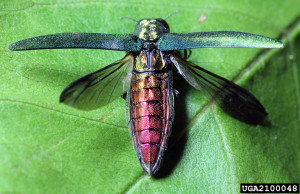Updated September 26, 2023

The emerald ash borer (EAB) is an exotic insect that belongs to a group of metallic wood-boring beetles. Unlike our native beetles that kill weakened trees as part of the natural nutrient recycling process, emerald ash borers kill vigorously growing and weakened ash trees. It is not native to the United States and was first found near Detroit, Michigan, in 2002. EAB is now found in 36 states and five Canadian provinces and has already killed hundreds of millions of ash trees.
EAB was discovered in DeKalb and Fulton counties in Georgia in July 2013 as part of the national detection survey funded by the USDA-Animal and Plant Health Inspection Service. Georgia has been part of a nationwide trapping program to detect the presence of this forest pest since 2005.
- As part of this trapping program, EAB was found in nine more counties in 2014: Carroll, Clayton, Cobb, Fayette, Henry, Newton, Rockdale, Walton, and Whitfield.
- In 2015, another 710 traps were placed around the state, and EAB was found in seven new counties: Barrow, Cherokee, Douglas, Fannin, Habersham, Murray, and White.
- In 2016, EAB was found in four new counties: Bartow, Gilmer, Rabun, and Union.
- In 2017, EAB was not found in any new counties.
- In 2018, 91 traps were set across the state, and EAB was found in three new counties: Dawson, Lumpkin, and Walker.
- In 2019, 79 traps were hung across the state, and EAB was found in seven new counties: Catoosa, Chattooga, Dade, Gordon, Jackson, Paulding and Spalding.
- In 2020, GFC foresters hung 65 traps across the state, and EAB was found in four new counties: Banks, Butts, Floyd, and Pickens.
- In 2021, GFC foresters hung 62 traps across the state, and EAB was found in seven new counties: Clarke, Hart, Forsyth, Franklin, Madison, Oconee, and Stephens.
- In 2022, GFC foresters hung 70 traps, and EAB was found in traps in 2 new counties and from bark sampling in 2 additional counties. New counties in 2022 include Hall, Jasper, Polk, and Putnam, bringing the total number of counties in GA with EAB to 48.
- In 2023, 89 traps were hung, and EAB was found in three new counties and two additional counties from bark sampling. New counties in 2023 include Towns, Haralson, Bibb, Greene, and Oglethorpe, bringing the total number of counties in GA with EAB to 53.
In December of 2017, the Georgia EAB quarantine was expanded to include the entire state. While there is no restriction on the movement of ash materials within Georgia, there are still restrictions on the movement of ash materials to Florida and Alabama. Ash materials can move freely to South Carolina and East Tennessee.
On December 15, 2020, the U.S. Department of Agriculture’s Animal Plant Health Inspection Service published a final rule in the Federal Register that removes federal domestic emerald ash borer (EAB) quarantine regulations. The final rule became effective on January 14, 2021, 30 days after publication. The program is now transitioning from a regulatory program to one focusing on managing pests, including biological control agents.
On March 1, 2021, the Georgia Forestry Commission (GFC) proposed the repeal of Chapter 224-3, “Emerald Ash Borer Quarantine,” in its entirety. Following an open comment period, on May 19, GFC’s Board approved this repeal and removal of the statewide EAB quarantine. On May 26, 2021, the Georgia Secretary of State’s office approved the final repeal to remove the EAB quarantine. This new rule, and removal of the statewide quarantine, became effective June 15, 2021.
As of September 22, 2023, EAB has been found in the following counties in Georgia.
| Banks | Dekalb | Haralson | Putnam |
| Barrow | Douglas | Hart | Rabun |
| Bartow | Fannin | Henry | Rockdale |
| Bibb | Fayette | Jackson | Spalding |
| Butts | Floyd | Jasper | Stephens |
| Carroll | Forsyth | Lumpkin | Towns |
| Catoosa | Franklin | Madison | Union |
| Chattooga | Fulton | Murray | Walker |
| Cherokee | Gilmer | Newton | Walton |
| Clarke | Gordon | Oconee | White |
| Clayton | Greene | Oglethorpe | Whitfield |
| Cobb | Gwinnett | Paulding | |
| Dade | Habersham | Pickens | |
| Dawson | Hall | Polk |
- EAB – Destructive Tree Pest Detected in Georgia (2013)
- EAB – GAinvasives.org
- EAB Chemical Treatments
- EAB Homeowner Decision Guide
- EAB Insecticide Fact Sheet
- EAB Update (2020)
- EAB Update (2021)
- EAB Update (2022)
- EAB Update (2023)
- Emerald Ash Borer (EAB) Rules & Regulations
- EmeraldAshBorer.info
- USDA APHIS EAB Story Map
